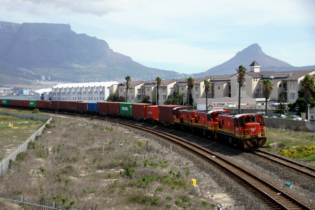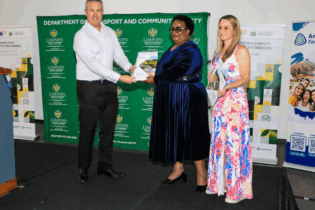Despite a softening of cargo categories, Transnet is going ahead with its infrastructure build programme.
“In the earlier months of the current financial year, we have seen a softening particularly with the container volumes – imports and exports that we handle – for a variety of reasons,” Transnet Port Terminals (TPT) chief executive officer Karl Socikwa said at a breakfast briefing of the Africa Ports and Harbours Show. Socikwa said TPT was keeping a close watch on developments in Europe. “We are not oblivious to what’s happening in Europe at the moment and despite that, we are proceeding with investment but we’re watching that closely. “Imports/exports are a function of the level of economic activity that’s taking place in the country. [There’s] little we can do in driving … import/export volumes – it’s more your transhipment volumes where [with] innovative ways, you can have a handle on it and we’re doing that,” he said on Tuesday. Shipping lines had indicated to TPT that they were not overly concerned about the softening as this could be due to a soft blip or a softening of demand from markets they are servicing in Europe. “They themselves are not in a situation where they are saying that they’re in crisis mode,” said Socikwa. TPT handles four types of cargo, namely container volumes; car volumes; break bulk and bulk volumes. Transnet is investing R300 billion in the Market Demand Strategy. Through the state-owned freight logistics group’s Market Demand Strategy, rail, port and pipeline infrastructure will be expanded over a seven-year period to the tune of R300 billion. Of the R300 billion, TNP will receive about 10% of the amount, translating to just over R33 billion. TPT provides cargo-handling services at seven of the country’s terminals. TPT customers include shipping lines, freight forwarders and cargo owners.“The nature of investment in port facilities will be your ship-to-shore cranes, yard cranes … We also will be investing in new technology in terms of the operating environment and our people,” said Socikwa, adding that the company’s annual budget reviews would enable them to analyse the pace at which investment was taking place over the seven-year period.
Should a need to revise or review the investment be identified, this would be possible as there was “sufficient flexibility” built into the system. The focus of the investment will be on human capital, assets and technology. “So a lot of investment is trying to reverse the historic trends of investment, so that we are not only investing in areas that have received attention in the past, but also starting to look at other areas in the business [to ensure] that there’s an even spread of economic activity,” said Socikwa. Richard’s Bay terminal will receive the lion’s share of the spend due to ageing infrastructure. The terminal is a complex one from an operational point of view as it handles a multitude of commodities, unlike Port Elizabeth that handles manganese or Saldanha that handles iron ore. Durban, the busiest and largest container terminal in the Southern Hemisphere, will be second in line, while Ngqura – which has seen major investment in the past, is set to get two more mega-max cranes to be added to the other six cranes at the terminal. At the Cape Town port, R5 billion has been spent in the last couple of years. On talk that rates charged at ports were too high, TPT said it didn’t believe this to be true. “We don’t believe rates are too high … We continue to monitor our costs as tightly as we can to make sure we are running an efficient business to generate the level of earnings necessary to fund investment,” said Socikwa. – BuaNews






